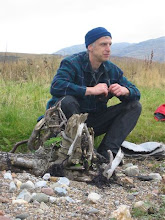
 I went out to the Moss this afternoon because my wife hadn't seen the viewing tower so we though a quick stroll round would do the job. However it was hooching. It was probably the busiest I have seen Flanders since we have opened the boardwalk with probably 30 + people going round in the time we were there. There were various people that I knew amongst the crowd and I chatted with several as we went round. They were all people with a link to the Moss, there were people who had volunteered on species surveys, people who had come for Christmas trees, people from local businesses that we had used for events on Flanders and local community councillor. Some of them had come down for the first time, some regulars but all had headed out to Flanders for a (freezing cold) breath of fresh air. And all had positive things to say about the Moss and how much they were enjoying their visit. It struck me that there quite a variety of ways that people came to know about the Moss and the different links that they had with the site. And 4 years ago none of them would have been out there as there was no boardwalk and virtually no links with local people. A result.
I went out to the Moss this afternoon because my wife hadn't seen the viewing tower so we though a quick stroll round would do the job. However it was hooching. It was probably the busiest I have seen Flanders since we have opened the boardwalk with probably 30 + people going round in the time we were there. There were various people that I knew amongst the crowd and I chatted with several as we went round. They were all people with a link to the Moss, there were people who had volunteered on species surveys, people who had come for Christmas trees, people from local businesses that we had used for events on Flanders and local community councillor. Some of them had come down for the first time, some regulars but all had headed out to Flanders for a (freezing cold) breath of fresh air. And all had positive things to say about the Moss and how much they were enjoying their visit. It struck me that there quite a variety of ways that people came to know about the Moss and the different links that they had with the site. And 4 years ago none of them would have been out there as there was no boardwalk and virtually no links with local people. A result.Another result (maybe) is that this blog has just got little bit better know. We were asked by the Stirling Observer if there was anything new happening at Flanders and they only thing I could think of was the blog. So a very short press release went out but also went out to a few other media. Suddenly someone in the office told me that the blog featured on the BBC Scotland website and then apparently it was in the Herald on Saturday. I even got sent a message on Facebook from a dog who had picked it up on the BBC. The pressure is on to deliver. So welcome to any new bog bloggers, I hope you enjoy what you read and maybe be encouraged to find out a bit more about this special site.
http://news.bbc.co.uk/1/hi/scotland/tayside_and_central/8485561.stm
































